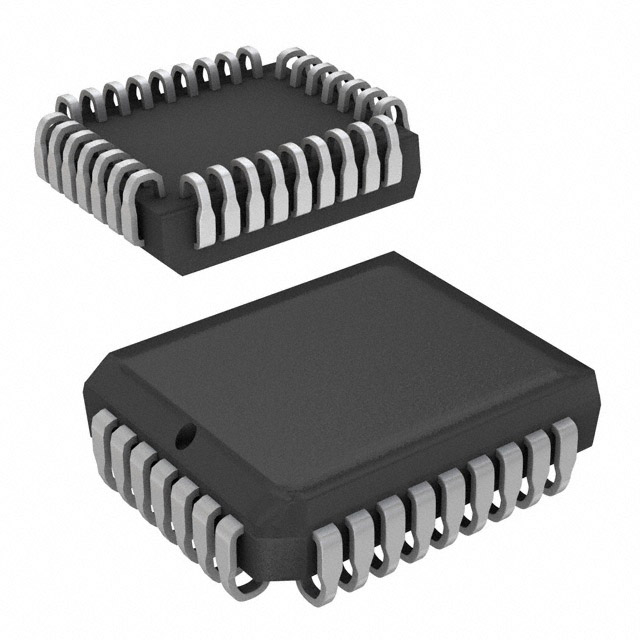AT28C256F-15JC
Product Overview
Category
AT28C256F-15JC belongs to the category of non-volatile memory devices.
Use
It is primarily used for storing and retrieving digital information in electronic systems.
Characteristics
- Non-volatile: Retains data even when power is turned off.
- High storage capacity: 256 kilobits (32 kilobytes).
- Fast access time: 150 nanoseconds.
- Low power consumption.
- Durable and reliable.
Package
AT28C256F-15JC is available in a 32-pin PLCC (Plastic Leaded Chip Carrier) package.
Essence
The essence of AT28C256F-15JC lies in its ability to provide non-volatile storage with high capacity and fast access times, making it suitable for various applications.
Packaging/Quantity
AT28C256F-15JC is typically packaged in reels or tubes, with quantities varying based on customer requirements.
Specifications
- Memory Capacity: 256 kilobits (32 kilobytes)
- Access Time: 150 nanoseconds
- Supply Voltage: 5V
- Operating Temperature Range: -40°C to +85°C
- Data Retention: 10 years
Detailed Pin Configuration
- A0 - Address Input
- A1 - Address Input
- A2 - Address Input
- A3 - Address Input
- A4 - Address Input
- A5 - Address Input
- A6 - Address Input
- A7 - Address Input
- A8 - Address Input
- A9 - Address Input
- A10 - Address Input
- A11 - Address Input
- A12 - Address Input
- A13 - Address Input
- A14 - Address Input
- A15 - Address Input
- /OE - Output Enable
- /CE - Chip Enable
- /WE - Write Enable
- VSS - Ground
- DQ0 - Data Input/Output
- DQ1 - Data Input/Output
- DQ2 - Data Input/Output
- DQ3 - Data Input/Output
- DQ4 - Data Input/Output
- DQ5 - Data Input/Output
- DQ6 - Data Input/Output
- DQ7 - Data Input/Output
- VCC - Supply Voltage
- NC - No Connection
- NC - No Connection
- /WP - Write Protect
Functional Features
- Random access to any memory location.
- Byte-wise programmable and erasable.
- Low power consumption during standby.
- Automatic write timing.
Advantages and Disadvantages
Advantages
- Non-volatile storage ensures data retention even without power.
- High storage capacity allows for storing large amounts of information.
- Fast access time enables quick retrieval of data.
- Low power consumption helps in energy-efficient designs.
- Reliable and durable, suitable for various applications.
Disadvantages
- Limited storage capacity compared to other modern memory devices.
- Relatively slower access times compared to newer memory technologies.
- Requires careful handling to prevent damage due to electrostatic discharge.
Working Principles
AT28C256F-15JC is based on Electrically Erasable Programmable Read-Only Memory (EEPROM) technology. It uses a grid of transistors to store digital information. The stored data can be read, written, and erased electronically.
Detailed Application Field Plans
AT28C256F-15JC finds applications in various fields, including: - Embedded systems - Automotive electronics - Industrial control systems - Consumer electronics - Communication devices
Detailed and Complete Alternative Models
Some alternative models to AT28C256F-15JC are: - AT28C256-15PU - AT28C256-15PC - AT28C256-15DM/883
These models offer similar functionality and specifications, providing options for different package types or operating temperature ranges.
In conclusion, AT28C256F-15JC is a non-volatile memory device with high storage capacity and fast access times. It finds applications in diverse fields and offers advantages such as data retention, reliability, and low power consumption. However, it has limitations in terms of storage capacity and access times compared to newer memory technologies.
Lista 10 Vanliga frågor och svar relaterade till tillämpningen av AT28C256F-15JC i tekniska lösningar
Sure! Here are 10 common questions and answers related to the application of AT28C256F-15JC in technical solutions:
Q: What is the AT28C256F-15JC? A: The AT28C256F-15JC is a high-performance, low-power CMOS 256K (32K x 8) EEPROM (Electrically Erasable Programmable Read-Only Memory) chip.
Q: What are the key features of the AT28C256F-15JC? A: Some key features include a wide operating voltage range, fast access time, low power consumption, and a high endurance for read/write cycles.
Q: What is the typical application of the AT28C256F-15JC? A: The AT28C256F-15JC is commonly used for storing program code or data in various electronic devices such as microcontrollers, embedded systems, and industrial control systems.
Q: How does the AT28C256F-15JC connect to a microcontroller or other devices? A: The AT28C256F-15JC uses a standard parallel interface, typically connected to the address bus, data bus, and control signals of the microcontroller or other devices.
Q: Can the AT28C256F-15JC be easily replaced with other EEPROM chips? A: Yes, the AT28C256F-15JC follows industry-standard pinout and electrical characteristics, making it compatible with many other EEPROM chips with similar specifications.
Q: What is the maximum operating frequency of the AT28C256F-15JC? A: The AT28C256F-15JC can operate at frequencies up to 15 MHz, allowing for fast read and write operations.
Q: How many times can the AT28C256F-15JC be written to or erased? A: The AT28C256F-15JC has a high endurance of at least 100,000 write/erase cycles, ensuring long-term reliability.
Q: Can the AT28C256F-15JC retain data without power? A: Yes, the AT28C256F-15JC is non-volatile, meaning it can retain stored data even when power is removed.
Q: What is the operating temperature range of the AT28C256F-15JC? A: The AT28C256F-15JC can operate within a temperature range of -40°C to +85°C, making it suitable for various environments.
Q: Is the AT28C256F-15JC RoHS compliant? A: Yes, the AT28C256F-15JC is RoHS (Restriction of Hazardous Substances) compliant, ensuring it meets environmental regulations.
Please note that these answers are general and may vary depending on specific datasheet information and application requirements.


